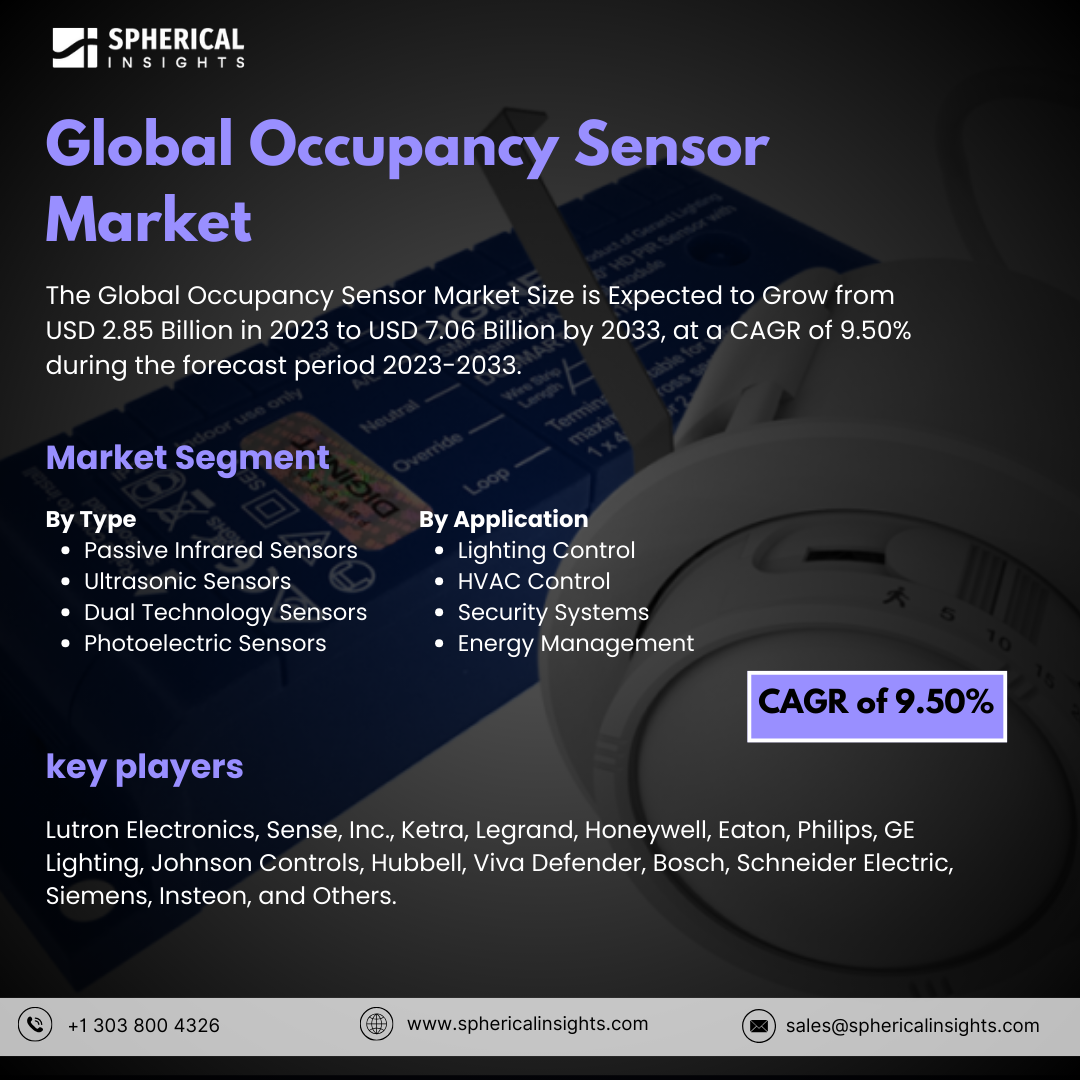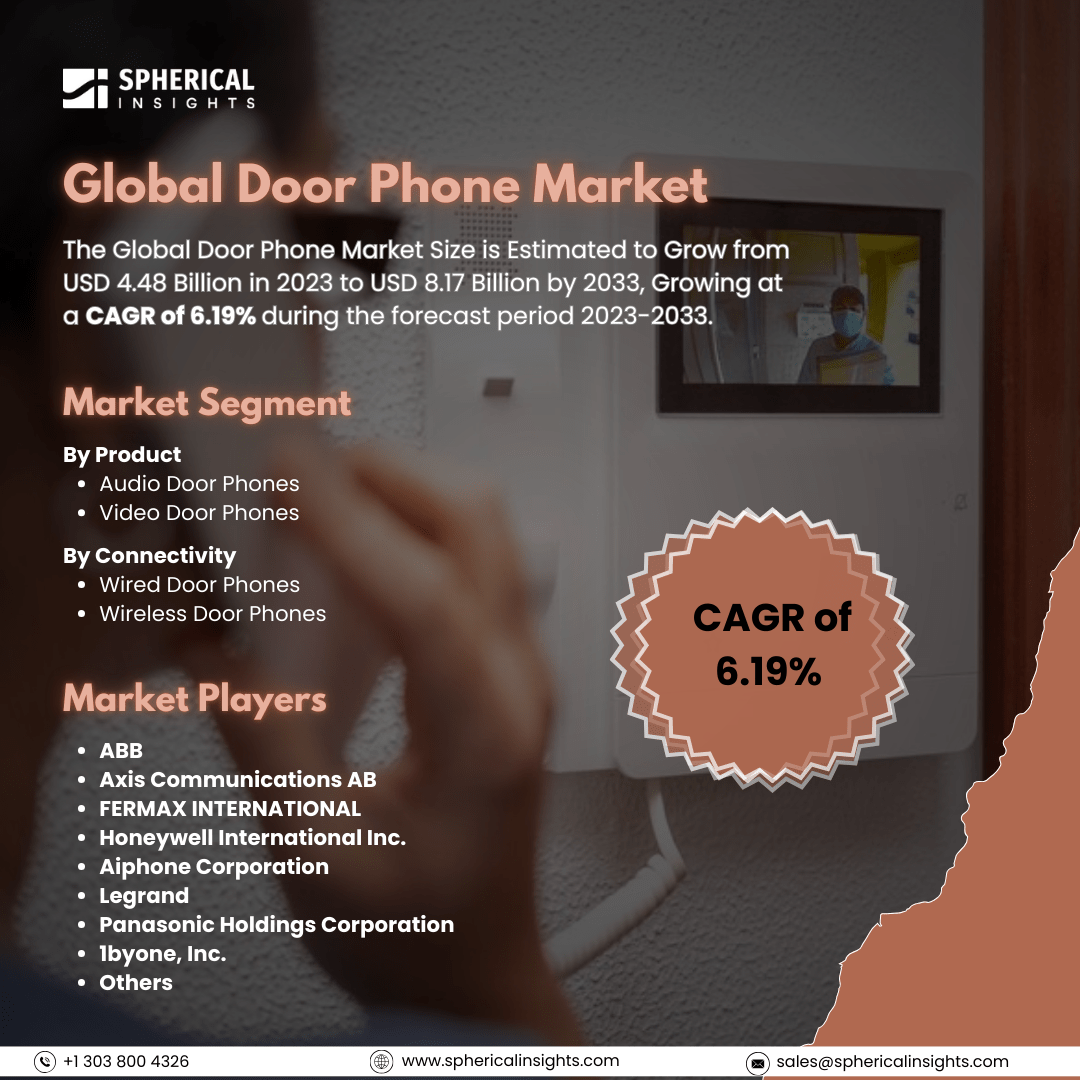Global Occupancy Sensor Market Size to worth USD 7.06 Billion by 2033
According to a research report published by Spherical Insights & Consulting, The Global Occupancy Sensor Market Size is Expected to Grow from USD 2.85 Billion in 2023 to USD 7.06 Billion by 2033, at a CAGR of 9.50% during the forecast period 2023-2033.
Browse key industry insights spread across 210 pages with 110 Market data tables and figures & charts from the report on the Global Occupancy Sensor Market Size, Share, and COVID-19 Impact Analysis, By Type (Passive Infrared Sensors, Ultrasonic Sensors, Dual Technology Sensors, and Photoelectric Sensors), By Application (Lighting Control, HVAC Control, Security Systems, and Energy Management), and By Region (North America, Europe, Asia-Pacific, Latin America, Middle East, and Africa), Analysis and Forecast 2023 – 2033.
An occupancy sensor is an indoor device used for detecting the presence of a person by using infrared, ultrasonic, microwave, or other technology. Applications include temperature, ventilation, and lighting systems that automatically adapt based on the number of people in the room. They typically save energy, provide automatic control, and comply with building codes. The increasing incorporation of Internet of Things (IoT) technology as well as the increased demand for smart building technologies are providing lucrative market growth opportunities for occupancy sensor. The growing demand for energy efficiency and technological advancements in sensor technology are driving the market growth. The implementation of stringent energy efficiency regulations by the government to reduce energy consumption and carbon emissions is promoting the occupancy sensor market. On the contrary, the inconsistency issues associated with wireless network systems when interacting with a lighting or HVAC system are challenging the market.
The passive infrared sensors segment dominated the market with the largest revenue share of the occupancy sensor market in 2023.
Based on the type, the occupancy sensor market is classified into passive infrared sensors, ultrasonic sensors, dual technology sensors, and photoelectric sensors. Among these, the passive infrared sensors segment dominated the market with the largest revenue share of the occupancy sensor market in 2023. In smart home applications, this sensor is effectively used for monitoring human presence and motion based on IR radiation emitted by living beings. The widespread application of PIR sensors and integration of IoT enables detection devices are driving the market growth.
The lighting control segment dominated the market with the largest share of the occupancy sensor market in 2023.
Based on the application, the occupancy sensor market is classified into lighting control, HVAC control, security systems, and energy management. Among these, the lighting control segment dominated the market with the largest share of the occupancy sensor market in 2023. The use of occupancy sensors helps improve energy savings by turning off or turning down the lights when rooms are unoccupied. The increasing use of consumer electronics and the demand for implementing renewable energy are driving the market demand.
North America is projected to hold the largest share of the global occupancy sensor market over the forecast period.
North America is projected to hold the largest share of the global occupancy sensor market over the forecast period. The rise in the construction industry particularly in the private sector is driving the market demand. Further, the increasing demand for energy-efficient devices owing to the trend on sustainable development and environmental responsibility is driving the market for occupancy sensor.
Asia Pacific is predicted to grow at the fastest CAGR in the occupancy sensor market over the forecast period. The growing demand for PIR devices in the region owing to the low cost and high energy efficiency is responsible for driving the market. The introduction of smart building technologies which enables access to accurate information about space occupancy contributes to driving the market growth.
Company Profiling
Major key players in the occupancy sensor market include Lutron Electronics, Sense, Inc., Ketra, Legrand, Honeywell, Eaton, Philips, GE Lighting, Johnson Controls, Hubbell, Viva Defender, Bosch, Schneider Electric, Siemens, Insteon, and Others.
Key Target Audience
- Market Players
- Investors
- End-users
- Government Authorities
- Consulting And Research Firm
- Venture capitalists
- Value-Added Resellers (VARs)
Recent Development
- In May 2024, Legrand’s lighting control brand, Vantage, announced it has partnered with WALL-SMART, a leader in flush wall mount solutions. This partnership enables WALL-SMART to seamlessly flush-mount Vantage keypads into any space, providing a clean and sophisticated look while maximizing functionality.
- In April 2024, Leviton announced the expansion of the Smart Sensor line with Smart Ceiling Mount Room Controllers (SRC) and Smart Ceiling Mount Sensors (CMS). The line simplifies advanced lighting controls by integrating several control strategies into a self-contained, cost-effective, and easy-to-install device.
- In January 2024, Lutron Electronics, the global leader in lighting control and automated shading solutions, announced the launch of new Maestro dual controls with built-in LED+ advanced dimming technology.
- In January 2024, Legrand, a global specialist in electrical and digital building infrastructures, including data centre solutions, announced its acquisition is complete of ZPE Systems, Inc., a Fremont company that offers critical solutions and services to deliver resilience and security for customers’ business-critical infrastructure.
- In February 2023, Leviton, a leading provider of electrical wiring devices, networking and lighting, announced the expansion of its manufacturing facility in Camargo, Mexico. The facility would manufacture products for all four Leviton business units and serve customers across the world. Incorporating automation and new technology in the facility would also improve Leviton’s ability to meet capacity demands, improve lead times and bring new products to market in a faster and more sustainable manner.
Market Segment
This study forecasts revenue at global, regional, and country levels from 2023 to 2033. Spherical Insights has segmented the global occupancy sensor market based on the below-mentioned segments:
Global Occupancy Sensor Market, By Type
- Passive Infrared Sensors
- Ultrasonic Sensors
- Dual Technology Sensors
- Photoelectric Sensors
Global Occupancy Sensor Market, By Application
- Lighting Control
- HVAC Control
- Security Systems
- Energy Management
Global Occupancy Sensor Market, Regional Analysis
- North America
- Europe
- Germany
- Uk
- France
- Italy
- Spain
- Russia
- Rest of Europe
- Asia Pacific
- China
- Japan
- India
- South Korea
- Australia
- Rest of Asia Pacific
- South America
- Brazil
- Argentina
- Rest of South America
- Middle East & Africa
- UAE
- Saudi Arabia
- Qatar
- South Africa
- Rest of Middle East & Africa



